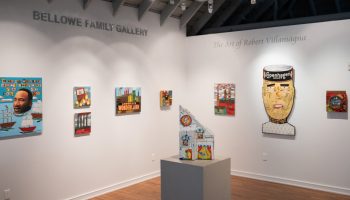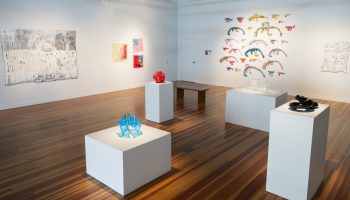
“Force of Nature” describes not only the landscape paintings by Gretna Campbell and Louis Finkelstein on view at Strohl Art Center, but also their personalities. At home in natural settings, they painted on the spot, just like the Impressionists a century earlier, continuing a tradition popular with viewers but not with late 20th-century critics. Their commitment to colorful landscapes led to more obscure careers, though they were well known as teachers — she at Yale, and he primarily at Queens College. This exhibition, selected by Don Kimes, artistic director of the Visual Arts at Chautauqua Institution, honors the two who were his mentors and friends.
Louis Finkelstein was also a critic, who put forth their beliefs in his writing. He seemed to feel that pure abstraction had lost a “mystical essence” as the abstract Expressionists concentrated on the heroic gesture on monumental canvases. Instead, he
championed an approach that relied on the senses, a movement that he called Abstract Impressionism. He cited Monet’s water lily paintings as the best example because the Impressionist was able to transcend optical realism by using all his senses. The differences Finkelstein describes are nuanced, but he seems determined to create a niche for the work he and his wife produced and to defend their decision to move back to recognizable landscapes after a foray into abstraction.
Campbell and Finkelstein pursued the liminal in the natural world, reflecting a contemplative experience of nature. Like their hero Monet, they attempted to recreate a specific moment in time. Dedicated to the natural landscape, they wanted to go beyond the literal representation of the world around them, something the abstract Expressionists did by excluding the tangible and emphasizing the intangible in their work. Combining aspects of abstract and Impressionist painting, Campbell and Finkelstein pulled back from the extremes, developed further in minimalism, to anchor their work in the real world while still prioritizing ephemeral effects, the passage of time and the interaction of light and color.

In fact, their paintings in this show should really be seen as a record of places they have been and lived, giving us a visual diary or travelogue. They invite the viewer into the work through foreground elements, such as trees or the edge of a porch in Finkelstein’s work or the start of a country path in Campbell’s. Sharing a personal experience, they also hope to elicit memories of similar places explored by the viewer. Her canvases can seem darker and moodier while his have a brighter light that seems to emanate from the canvas itself. What unites their work is the variety of brushstrokes, used to suggest trees, fences, and even figures, that animate the surface of their works. Despite their differences, however, both were interested in the suggestive rather than the literal.
Kimes characterizes them as a yin/yang couple with Finkelstein as an intellectually curious man who pursued a variety of interests, both in art and other disciplines, while Campbell was more intuitive. Finkelstein frequently included abstracted figures in his landscape, with references to painters like Bonnard or Matisse, and in work not included in the show, his palette is notably brighter and vivid. Campbell seems closer to the cubists, especially in the broader planes used in her muted Maine seascapes, some of her first representational works.
There is a fascinating question that precedes the landscape paintings by the two. Why would artists who were part of the conversation about ART, the meaning of abstract painting during the heyday of abstract Expressionism and the beginning of minimalism in New York City, turn their backs on these dominant styles to start a long engagement with landscape painting? While we don’t have the exact answer to that intriguing question, their shift places them squarely within the tradition of American landscape painting, which grew from firmly embedded American values about land and frontier and continued to flourish when Europeans had abandoned the illusion of spatial depth to pursue surface flatness. New ways of seeing initiated the move to abstraction that came later to the new world. Early proponents, including Georgia O’Keeffe and Arthur Dove, also retreated to a more realistic style, and pure abstraction didn’t take over as the dominant style until the abstract Expressionists. Like their American predecessors, Campbell and Finkelstein felt more comfortable with their landscapes.
Was this the right move for the couple, and should their work be reassessed in the context of a changing history of art that allows for pluralism? The first step is this exhibition that will travel to other venues. Serious scholarship, like a Ph.D. dissertation, should examine their work and discuss it in reference to the times and what their colleagues were making. Only then can we determine their place in the larger context.
Vicky A Clark, is an independent curator, critic, and teacher based in Pittsburgh. She is currently working on the 2018 Biennial in Islamabad, Pakistan.




